Excerpt:
The agency has a history of diving into big construction projects that exceed projected costs, fall short on projected benefits and, in some cases, create new problems that engineers hadn’t bargained for.
Since it was founded in 1802, the U.S. Army Corps of Engineers has taken on some of the nation’s most ambitious attempts to manipulate nature for the benefit of human beings. The agency’s motto — “Essayons!” — translates from French to “Let Us Try!” And try it does.
The Corps has plunged ahead time and again with billion-dollar construction projects based on assumptions that don’t exactly pan out. In some cases, the agency goes on to spend billions more restoring the natural environment it manipulated.
We reported in late October on the Corps’ $1.9 billion proposal to remedy the fact that its 13 dams on the Willamette River in Oregon have helped drive iconic salmon to the brink of extinction.
Trouble is, that recovery plan is also based on assumptions that might not match reality. Central to what the Corps proposes is a pair of fish collectors, which the agency describes as essentially giant fish vacuums. Salmon the size of baby carrots would be whooshed into it, trapped in tanks and trucked around dams on their migration to the sea. The devices are to be built on a massive scale never before tested, and the Corps estimates a single collector could cost up to $450 million. A recent scientific review concluded that the kind of approach the Corps is pitching in Oregon won’t save salmon but “only prolong their decline to extinction.”
The Corps says it’s the best option for helping salmon while keeping dams operational for hydropower customers, boaters and other users of the Willamette systems — although many of those users say they would be fine with lowering reservoirs and curtailing hydropower if it helped fish.
The Oregon story is one example in a long line of Corps projects that have drawn criticism over the years.
In 1971, the New York Times editorial board declared “the American people are becoming increasingly fed up with the expensive, boondoggling, make‐work, environmentally destructive projects that to a large degree characterize the civilian activities of the Army’s Corps of Engineers.”
Three decades later, a Washington Post investigation found the Corps pursued “billions of dollars’ worth of taxpayer-funded water projects, many with significant environmental costs and minimal economic benefits.”
The Government Accountability Office concluded in 2006 that the Corps’ work was “fraught with errors, mistakes, and miscalculations, and used invalid assumptions and outdated data.”
ProPublica, with its partner Reveal from the Center for Investigative Reporting, has reported that the Corps knew since 1852 that levees force rivers to run higher and faster and yet persisted in using them for flood control.
When asked for a response to critics, the Corps this week issued a statement in which it acknowledged “over our 248-year history there have been challenges associated with some of our projects. As an organization, we are always striving to be better.”
The agency said lessons learned from past projects have prompted changes to planning processes and the incorporation of “independent peer review.” The Corps said it’s working to modernize business methods, materials and designs while evolving in its approach to environmental and social concerns. Corps leaders are committed, the statement said, “to safely deliver projects, on time and within budget.”
Here are some examples of Corps projects that didn’t go as expected.
New Orleans levee system…
Tennessee-Tombigbee Waterway…
St. John’s Bayou-New Madrid Floodway…
Olmsted locks and dam..
Savannah harbor dredging…
Florida Everglades restoration…
Controlling Columbia River salmon predators…
Coast fortification in New Jersey…
Dredging the Mississippi…









